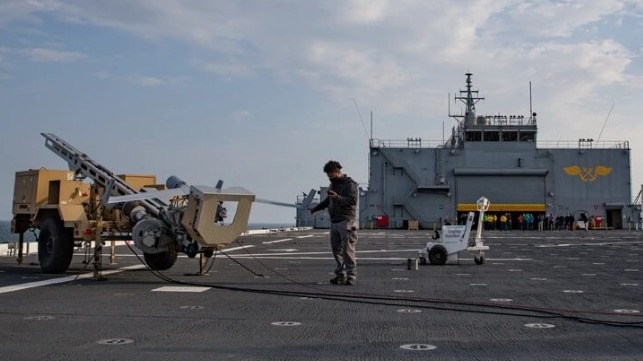Rise of Hybrid Warfare Drives New Approach for Naval Services

A recent interview with Thales Naval Defence Advisor, Vice Admiral (Rtd) Éric Chaperon revealed how international geopolitical changes are having a trickle-down effect on the way naval forces operate at sea. Tensions have been high since Russia’s invasion of Ukraine in February 2022. East-West geopolitical competition is also contributing to a changing world order with implications for maritime, for instance amongst Latin American countries.
Tensions have led to a “locking down” of the open seas, according to Vice Adm. Chaperon. Militaries are increasingly limited by anti-access and area-denial strategies so that “the freedom of forces to operate in contested waters is becoming more and more restricted.” In order to find ways round this, a multitude of mechanisms and methods are being used, “ranging from assaults by drones or drone swarms to salvo attacks by long-range hypersonic missiles or super-torpedoes, as well as lasers and electromagnetic weapons, electronic warfare, cyber warfare, and now seabed warfare.”
As a result, the threat landscape has widened significantly. One particular impact is increasingly hybrid warfare. Drones are taking a more prominent role in naval warfare, which represents “both a risk and an opportunity.” This is posing new challenges to defending territory, as drones can be in used in many different situations and ways, compared to more kinetic instrumentss. Eliminating the human being from warfare has legal implications which impacts how the threat is tackled; there are different consequences for taking down another state’s drone versus their ships. Drones are consequently more commonly used, increasing the number of potential attacks.
Unidentified drone swarms visited U.S. Navy vessels off California and Hong Kong in 2017-19, including this run-in with the cruiser USS Zumwalt (video courtesy USN/The War Zone)
As such, military infrastructure needs to adapt to the use of new technology such as drones, alongside more traditional kinetic methods. This need is driving changes. Firstly, it motivates closer collaboration between “the different players of capability development – users, customers and industry partners.” Rather than approaching this problem as individual states, increased interoperability and resources sharing (for example, within NATO or the EU) will play a significant role in tackling these challenges.
There is also a need for increased autonomous controls in order to manage drones securely in a contested environment. The autonomous nature of their operation opens drones up to threats of hijacking and interception. In terms of hijacking, attackers can exploit the small storage disk ports within drones, use Wi-Fi or perhaps a subscription service like Aerial Armor to detect drone flight paths, and de-authenticate and take over the drone’s control to land it in a favorable location.
Unencrypted drone video has also been intercepted in Iraq and Israel, with widespread implications. In state-on-state conflict, a state’s military can gain intelligence about the location and tactics of opposing navies, and even derail missions by redirecting drones carrying vital supplies or weapons.
Navies will continue to be impacted by the increasing role of technology, including drone systems. They pose both logistical and security challenges which will only be overcome with efficient management and improved cyber security measures.
Jessie Hamill-Stewart is a cybersecurity PhD student at University of Bristol and University of Bath.
Andrew Sallay is the CEO and co-founder of cybersecurity company Reperion.
Sources
https://www.thalesgroup.com/en/worldwide/group/magazine/free-and-open-seas-are-progressively-being-locked-down
https://rusi.org/explore-our-research/publications/commentary/latin-american-countries-geopolitical-competition-begins-sea
https://cybernews.com/security/drones-hack-airborne-cybersecurity-nightmare/#:~:text=Common%20attacks%20against%20enterprise%20drones,in%20a%20location%20of%20its
https://ccdcoe.org/uploads/2018/10/Art-14-Assessing-the-Impact-of-Aviation-Security-on-Cyber-Power.pdf
The opinions expressed herein are the author's and not necessarily those of The Maritime Executive.
